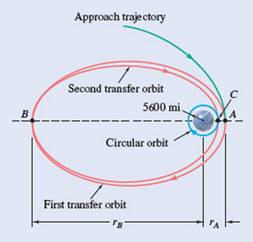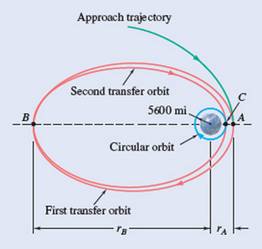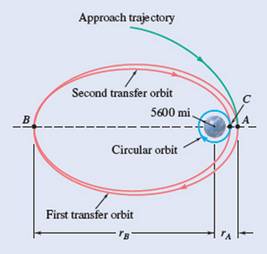
Concept explainers
A space probe is to be placed in a circular orbit of 5600-mi radius about the planet Venus in a specified plane. As the probe reaches A, the point of its original trajectory closest to Venus, it is inserted in a first elliptic transfer orbit by reducing its speed by

(a)
The velocity of the probe should be reduced at point
Answer to Problem 12.105P
The velocity reduction at point
Explanation of Solution
Given information:

Initial velocity corresponding to a parabolic orbit,
Angular momentum of a unit mass,
If the trajectory is an elliptical orbit,
Calculation:
Initial velocity corresponding to a parabolic orbit,
Since,
Then consider the first transfer elliptical orbit,
Applying angular momentum equation,
Therefore the velocity reduction at point
(b)
The velocity of the probe should be reduced at
Answer to Problem 12.105P
The velocity reduction at point
Explanation of Solution
Given information:

Angular momentum of a unit mass,
If the trajectory is an elliptical orbit,
Calculation:
Consider the first transfer elliptical orbit,
Then consider the second transfer elliptical orbit,
Since,
Applying angular momentum equation,
Therefore, the velocity reduction at point
(b)
The velocity of the probe should be reduced at
Answer to Problem 12.105P
The velocity reduction at point
Explanation of Solution
Given information:

Angular momentum of a unit mass,
Initial velocity corresponding to a circular orbit,
Calculation:
Consider the second transfer elliptical orbit,
Then consider the circular orbit at
Since,
Therefore the velocity reduction at point
Want to see more full solutions like this?
Chapter 12 Solutions
Vector Mechanics For Engineers
- 2B Show that in a field of attractive forces F(r) a body of mass m can always perform circular motion of radius r0 with constant angular velocity w. Also show that the velocity u of the circular orbit is given by the relation u² == ToF (1) marrow_forwardM XCM M A binary system is shown by the image above. It consists of two stars of equal mass. These stars revolve in a circular orbit about thgeir center of mass, which is midway between them. If the orbital speed of each star is 2,280 km/s and the orbital period of each is 11.7 days. Find the mass M of each star.arrow_forwardA spacecraft traveling along a parabolic path toward the planet Jupiter is expected to reach point vA of magnitude 26.9 km/s. Its engines will then be fired to slow it down, placing it into an elliptic orbit which will bring it to within 100 × 103 km of Jupiter. Determine the decrease in speed ? v at point A which will place the spacecraft into the required orbit. The mass of Jupiter is 319 times the mass of the earth.arrow_forward
- A space shuttle is describing a circular orbit at an altitude of d= 570 km above the surface of the earth. As it passes through Point A, it fires its engine for a short interval of time to reduce its speed by 208 m/s and begin its descent toward the earth. Determine the angle AOB so that the altitude of the shuttle at Point B is 128 km. d B A R = 6370 km The angle AOB isarrow_forwardA space probe is to be placed in a circular orbit of radius 4o00 km about the planet Mars. As the probe reaches A, the point of its original trajectory closest to Mars, it is inserted into a first elliptic transfer orbit by reducing its speed. This orbit brings it to Point B with a much reduced velocity. There the probe is inserted into a second transfer orbit by further reducing its speed. Knowing that the mass of Mars is 0.1074 times the mass of the earth, that ra= 9004 km and rg= 180 004 km, and that the probe approaches A on a parabolic trajectory, determine the time needed for the space probe to travel from A to Bon its first transfer orbit. Approach trajectory Second transfer orbit В 4000 km First transfer orbit The time needed for the space probe to travel from A to B on its first transfer orbit is |h.arrow_forwardA satellite describes an elliptic orbit of minimum altitude 606 km above the surface of the earth. The semimajor and semiminor axes are 17,440 km and 13,950 km, respectively. Knowing that the speed of the satellite at Point C is 4.78 km/s, determine (a) the speed at Point A, the perigee, (b) the speed at Point B, the apogee. 606 km R = 6370 km 13 950 km B, A 17 440 km 17 440 kmarrow_forward
- To place a COmm cations satellite Into a geosynchronous orbit at an alt bove the surface of the ea the satellite is first released from a space shuttle, which is in a circular orbit at an altitude of 185 mi, and is then propelled by an upper-stage booster to its final altitude. As the satellite passes through A, the booster's motor is fired to insert the satellite into an elliptic transfer orbit. The booster is again fired at B to insert the satellite into a geosynchronous orbit. The second firing increases the speed of the satellite by 4870 ft/s. 22 240 mi 185 mi A R= 3960 mi, Determine the speed of the satellite as it approaches Bon the elliptic transfer orbit. (You must provide an answer before moving to the next part.)arrow_forwardA space probe is describing a circular orbit about a planet of radius R. The altitude of the probe above the surface of the planet is aR and its speed is v0 . To place the probe in an elliptic orbit which will bring it closer to the planet, its speed is reduced from v0 to βv0 , where β < 1, by firing its engine for a short interval of time. Determine the smallest permissible value of β if the probe is not to crash on the surface of the planet.arrow_forwarddetermine (a) the speed of the vehich as it approaches B on the elliptic path, (b) the amount by which its speed should be reduced as it approaches B to insert it into the smaller circular orbit.arrow_forward
- A satellite describes an elliptic orbit about a planet of mass M . The minimum and maximum values of the distance r from the satellite to the center of the planet are, respectively, r0 and r1. Use the principles of conservation of energy and conservation of angular momentum to derive the relationwhere h is the angular momentum per unit mass of the satellite and G is the constant of gravitation.arrow_forwardThree identical point masses of m = 0.1 (kg) are moving at a constant velocity v=10 (m/s) equidistant from each other on a circular orbit of radius R = 0.4 (m). What is the total angular momentum (kg.m²/s) of the three point masses relative to point A at the moment shown in the figure. Point A is 2R away from the center. m 2R A m R m A) 0.9 В) 1.2 С) 1.8 D) 3.0 E) 3.6arrow_forwardThree identical point masses of m =0.2 (kg) are moving at a constant velocity v =20 (m/s) equidistant from each other on a circular orbit of radius R = 0.3 (m). What is the total angular momentum (kg.m²/s) of the three point masses relative to point A at the moment shown in the figure. Point A is 2R away from the center. m 2R m a: m A) 0.9 В) 1.2 С) 1.8 D) 3.0 E) 3.6arrow_forward
 Elements Of ElectromagneticsMechanical EngineeringISBN:9780190698614Author:Sadiku, Matthew N. O.Publisher:Oxford University Press
Elements Of ElectromagneticsMechanical EngineeringISBN:9780190698614Author:Sadiku, Matthew N. O.Publisher:Oxford University Press Mechanics of Materials (10th Edition)Mechanical EngineeringISBN:9780134319650Author:Russell C. HibbelerPublisher:PEARSON
Mechanics of Materials (10th Edition)Mechanical EngineeringISBN:9780134319650Author:Russell C. HibbelerPublisher:PEARSON Thermodynamics: An Engineering ApproachMechanical EngineeringISBN:9781259822674Author:Yunus A. Cengel Dr., Michael A. BolesPublisher:McGraw-Hill Education
Thermodynamics: An Engineering ApproachMechanical EngineeringISBN:9781259822674Author:Yunus A. Cengel Dr., Michael A. BolesPublisher:McGraw-Hill Education Control Systems EngineeringMechanical EngineeringISBN:9781118170519Author:Norman S. NisePublisher:WILEY
Control Systems EngineeringMechanical EngineeringISBN:9781118170519Author:Norman S. NisePublisher:WILEY Mechanics of Materials (MindTap Course List)Mechanical EngineeringISBN:9781337093347Author:Barry J. Goodno, James M. GerePublisher:Cengage Learning
Mechanics of Materials (MindTap Course List)Mechanical EngineeringISBN:9781337093347Author:Barry J. Goodno, James M. GerePublisher:Cengage Learning Engineering Mechanics: StaticsMechanical EngineeringISBN:9781118807330Author:James L. Meriam, L. G. Kraige, J. N. BoltonPublisher:WILEY
Engineering Mechanics: StaticsMechanical EngineeringISBN:9781118807330Author:James L. Meriam, L. G. Kraige, J. N. BoltonPublisher:WILEY





